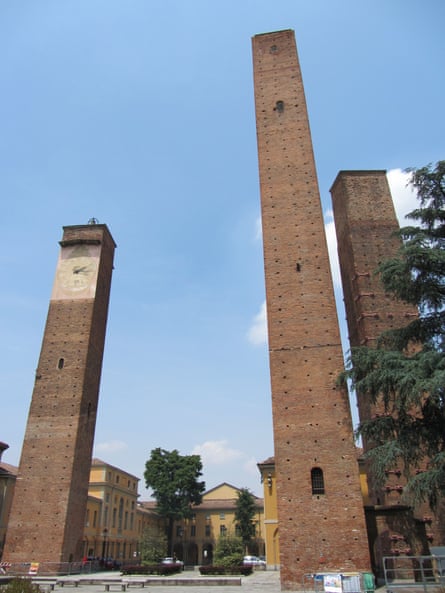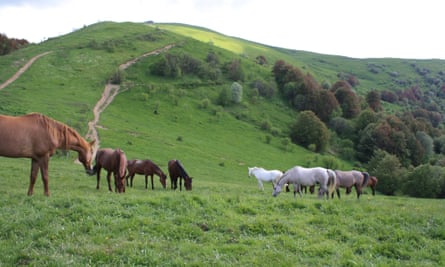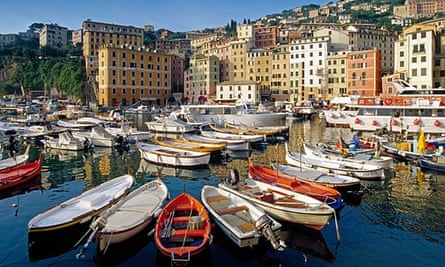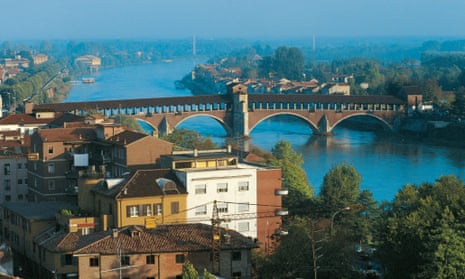It was while standing near our hotel at Capanne di Cosola that my sympathy for mules reached its zenith. From our vantage point at an altitude of 1,500 metres, we gazed out over at least a dozen chains of craggy silver-blue peaks melting into the late afternoon haze before the distant Mediterranean brought some horizontal sanity to the scene. For hundreds of years from the Middle Ages onwards, mule trains loaded with sea salt would labour up to these heights from the coast, crossing range after range of the Ligurian Apennines, which separate the Gulf of Genoa from the Po valley in north-west Italy.
One of the salt merchants’ major markets was the prosperous city of Pavia where, at one time, a kilo of salt reportedly commanded a cool £19,000 in today’s money. The network of paths this outrageously precious cargo travelled on became known as the Via del Sale, the Salt Road, and over six days a friend and I tramped 80 miles (without mules) along one of the major branches of this once-great trade route.
Happily, we were following the mules’ return journey, from the heights down to the coast, so there was usually more down than up each day. Our sole burdens were the packed lunches supplied by innkeepers along the way, and a map with route instructions provided by On Foot Holidays, which started offering this itinerary two years ago. The company suggests doing it in May, June or September – we set off in May – but it runs departures from April to October.
To ease ourselves into the journey we kicked off with a day roaming the streets of Pavia, which in the early middle ages was the capital of the Kingdom of the Lombards. It was known as the City of 100 Towers (though there were only 78), thanks to wealthy medieval owners who tried to outdo their neighbours by building these almost windowless brick skyscrapers hundreds of feet into the air, similar to those of the better-known San Gimignano in Tuscany. There are just 35 left today but, given their matchstick-like proportions, it’s astonishing that any survived at all.

But higher peaks than these were calling, so having notched up a swim in the pool of our villa in the village of Mornico Losana, we set off southwards through Oltrepò Pavese, the region “beyond the river Po”, otherwise known as Little Tuscany. The previous night we had seen off a bottle of Bonarda, a slightly sparkling red wine that quickly captured a place in our hearts.
“Is it local?” I asked Paolo, owner of the villa. “Well, that one’s from about 800 metres away,” he replied with a smile.
The route took us along grassy paths through the Bonarda vineyards, for which we had a new-found appreciation, before heading into the Apennine foothills where vast forests of sweet chestnuts replaced the vines. As must have been the case in the days of the Salt Road, much of the food we consumed at our consistently comfortable lodgings had been foraged. Chestnuts, acacia flowers (mouthwatering in tempura), alpine herbs, nettles and salvia leaves all found their way on to our plates. My favourite was a wild fungi and pasta dish called maltagliati del frantoio by chef Enzo at Albergo Caprile on the outskirts of Uscio, who came out of his kitchen to reveal the secrets of its creation.
One secret he did not reveal was how any visitor to the area stays thin: today’s Ligurian innkeepers have an unshakable conviction that anyone who goes walking cannot possibly survive on anything less than a six-course cena. The combination of strenuous walking by day and gargantuan meals at night meant we ended our week fit but fat.
After an unscripted double wading of the wide river by the ancient market town of Varzi (we’d foolishly left a map in our hotel there and the bridge was way downstream), we at last hit the mountains proper. And with the mountains came the alpine flowers – royal blue gentians, mauve pansies, ivory asphodels, orchids in their thousands. There were fungi aplenty, too. At a rustic mountain refuge we got chatting with Vittorio, a cheery man in a red-checked shirt, who opened a plastic bag to reveal a pile of freshly picked, focaccia-coloured mushrooms with creamy gills and stumpy stalks. “In July, they grow tall like trees,” he told us with a grin.
Along high ridges we hiked, bagging some peaks, skirting others, never quite sure what the next mule track or footpath would show us. One minute we were looking down on a maze of thickly wooded gorges; the next we were surprising a deer or posse of wild horses. There was so much going on, we missed some of it: we were told that if only we’d had a proper look back on the summit of Monte Chiappo, we might have seen all the way to Venice.

Hannibal and his elephants used this route in 218BC, picking up Ligurian recruits to fight the Roman Empire. Just 2,112 years later, a 16-year-old Albert Einstein walked it with a friend on his way to visit an uncle. Lying in their sleeping bags one night on top of Monte Antola, Einstein spotted Mercury and reflected on its bizarre orbit. The event is said to have sown a seed in young Albert’s mind that would grow into his theory of relativity. Sadly, we experienced no such world-shaking revelations on Antola, though we did enjoy the display of gravity-defying acrobatics the swallows put on for us, diving so close to our faces we could hear the whine and whip of their wings.
And at last we came to Camogli, a jaunty harbour town, clinging limpet-like onto a precipitous hillside, which Charles Dickens described as the “saltiest, roughest, most piratical little place”. Waving a fond farewell to our very last ridge, we dropped down countless flights of steps which, like something out of a dream, led only to more steps as, in unaccustomed humidity, we burrowed our way between colossal villas. Gone were the alpine flowers and in their place sprang groves of oranges, lemons and olives, while the air was scented by vast arrays of jasmine, wisteria and bougainvillea.

Our large and swanky beachside hotel, Cenobio dei Dogi, is something of an institution in these parts. It recently made an appearance in television show The Trip, the Steve Coogan and Rob Brydon haut-cuisine-and-impersonation-battles comedy. Feeling that our grubby and sweaty post-ambulatory state was not in keeping with our plush new surroundings, we plunged into the sea off the hotel’s bijou private beach without further ado.
I can tell you, the healing qualities of salt water on tired feet are something to be marvelled at. But this was sea salt that was staying right where it was.
Way to go
The trip was provided by On Foot Holidays , whose eight-night trip, with accommodation, luggage transfers and most meals, costs from £895pp. Voyages SNCF provided train travel: London-Voghera and Camogli-London from £214 return 0844 848 5848, voyages-sncf.com

Comments (…)
Sign in or create your Guardian account to join the discussion